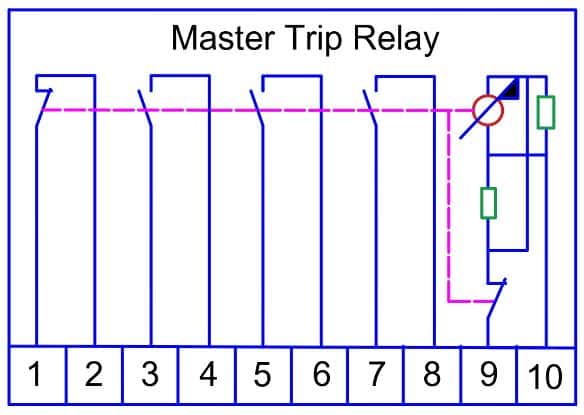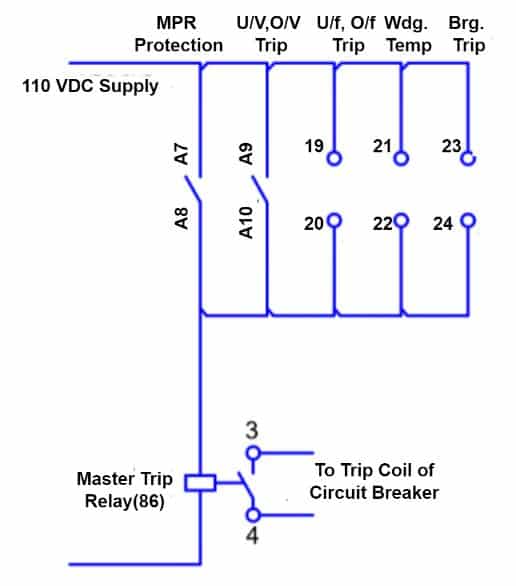Master Trip Relay is one of the important auxiliary relays in the power system. The master trip relay receives the input signals from the various protection relays and outputs the tripping command to a circuit breaker. Thus, the master trip relay is wired with a circuit breaker trip coil, and it is the final element that issues a trip command to a circuit breaker.
When the fault occurs in a power system, the corresponding protection relay trips and it outputs a signal to the master relay trips. Further, the master trip relay trips the circuit breaker.
Master Trip relay is not a protection relay and it can not sense the fault. It is a type of auxiliary relay that functions as a bridge between the protection relays and the circuit breaker trip coil. The ANSI code of the master trip relay is 86.
Significance of Master Trip Relay(86)
- Master trip relay receives the signal from protection relays and outputs tripping command to trip coil of a circuit breaker. Thus, it provides isolation between the protection relays and the circuit breaker’s trip coil. If we directly wire protection relays to the trip coil of a circuit breaker and a fault occurs in a trip coil, then it may cause burning of protection relay contact. The protection relays are expensive therefore direct interfacing of the protection relay with the trip coil is not advisable. A master trip relay is thus used for providing isolation between the protection relays and the breaker’s trip coil.
- The use of a master trip relay reduces the complexity of wiring. If the master trip relay is not used, then we have to wire all trip contacts of the protection relays to the circuit breaker’s trip coil. The output of the protection relays has 110 VDC and thus the DC voltage routes in the breaker for each protection relay. Thus, there are more chances of DC voltage leakage. It reduces the reliability of the protection system. Moreover, a lot of wiring cause more cost. If we use a master trip relay we need to carry two wires to the tripping coil.
- Master relay has multiple contacts that can be used for interlocking for tripping other breakers, annunciation, and signaling to PLC or SCADA.
- A master trip relay is a high-speed auxiliary tripping relay and it immediately issues a trip command to the circuit breaker’s trip coil. The operating time of the relay is 10 milliseconds nominal, at rated voltage.
- We can not directly wire the protection relays with a circuit breaker’s trip coil that does not have anti pumping circuit. The anti-pumping circuit interrupts the tripping command once the breaker gets tripped. Master trip relay releases a single pulse for tripping and thus, no anti-pumping circuit is required in a circuit breaker.
Working of Master Trip Relay(86)
The master trip relay issues a single pulse trip command to a circuit breaker on receiving the trip signal from any of the protection relays connected to it. The block diagram of the relay is given below.

The master trip relay issues a single command to a trip command to a trip coil of a circuit breaker. The wiring diagram of the master trip relay is shown in the below diagram.

Classification of Master Trip Relay
There are three categories of master trip relays on the basis of fault detection level. some of the faults need annunciation and no tripping, whereas some faults need immediate electrical isolation. Three categories of the master trip relay are as follows.
- Low-Level Trip ( ANSI code 86L)
- Medium Level Trip ( ANSI code 86M)
- Heavy Level Trip ( ANSI code 86H)
Low-Level Trip ( ANSI Code 86L)
These relays are used for tripping an auxiliary circuit breaker. The relay does not trip the entire power network if the fault level is low, and it outputs the signal for annunciation purposes.
Medium Level Master Trip Relays(ANSI Code 86M)
When the generator is running in synchronization with the grid supply, and faults such as overcurrent, instantaneous overcurrent, and earth fault occur at the grid supply, then the generator should isolate from the grid supply. This is what exactly the medium-level master trip relay does. The relay first trips the grid breaker and if the fault level is still high then the relay trips the generator breaker.
Also, in the case of mechanical failure of generating station equipment, such as oil pressure low, ACW (Auxiliary cooling Water) flow low, MCW (Main Cooling Water) Pressure low the medium level master trip relay trips the generator breaker and annunciate the alarm. Thus, the grid supply isolates from the generator supply.
Heavy Trip 86H:
If the magnitude of the fault is very high, it may damage the electrical as well as mechanical equipment. The heavy trip relay 86H output is wired with turbine tripping, Grid breaker tripping, and Generator breaker tripping. The heavy Trip relay also called Lock Out relay issues a trip command to the grid breaker, generator breaker, and turbine.
When the protection relays sense the following fault the 86H relay outputs a trip command.
- Instantaneous Earth Fault
- Restricted Earth Fault(REF)
- Standby Earth fault
- Differential relay
- 86 H- Turbine Side
Relay 86 H issues a trip command to the following equipment.
- Generator breaker
- Grid breaker
- Turbine
- Annunciation
Resetting Master Trip Relay
The relay can be reset if the fault does not persist.